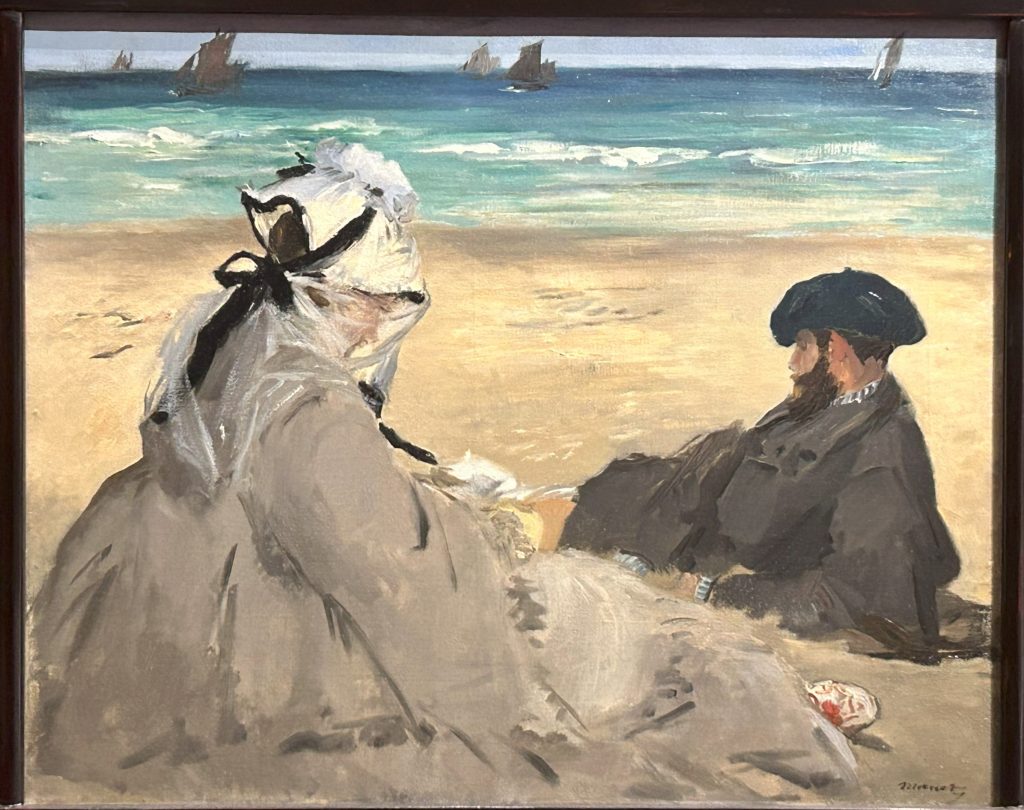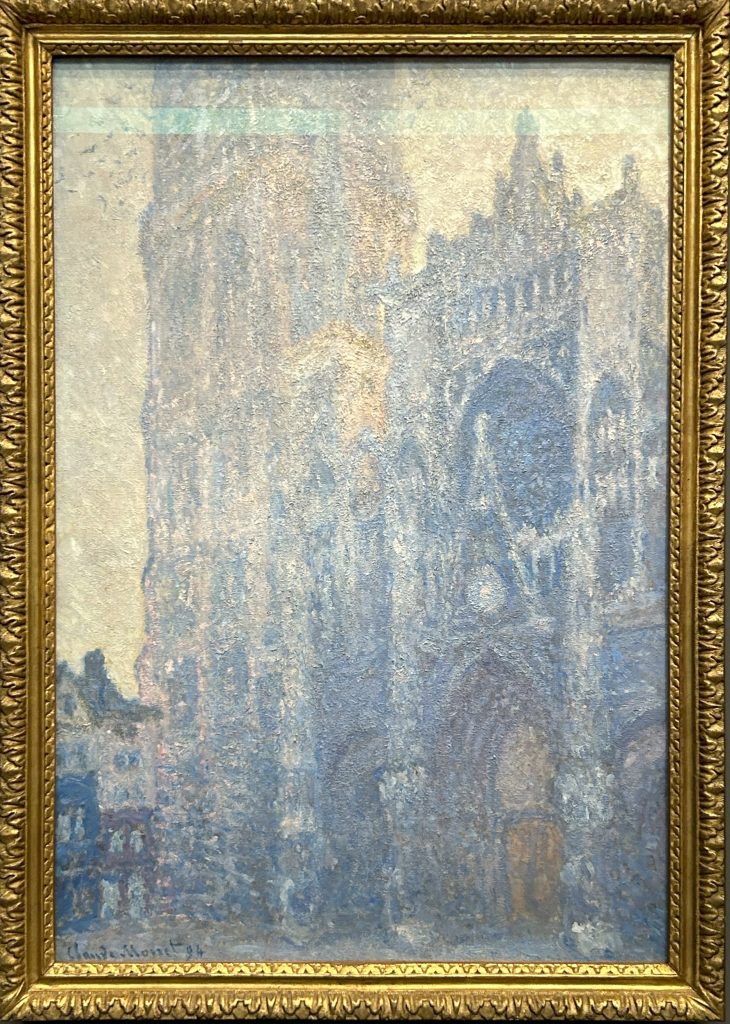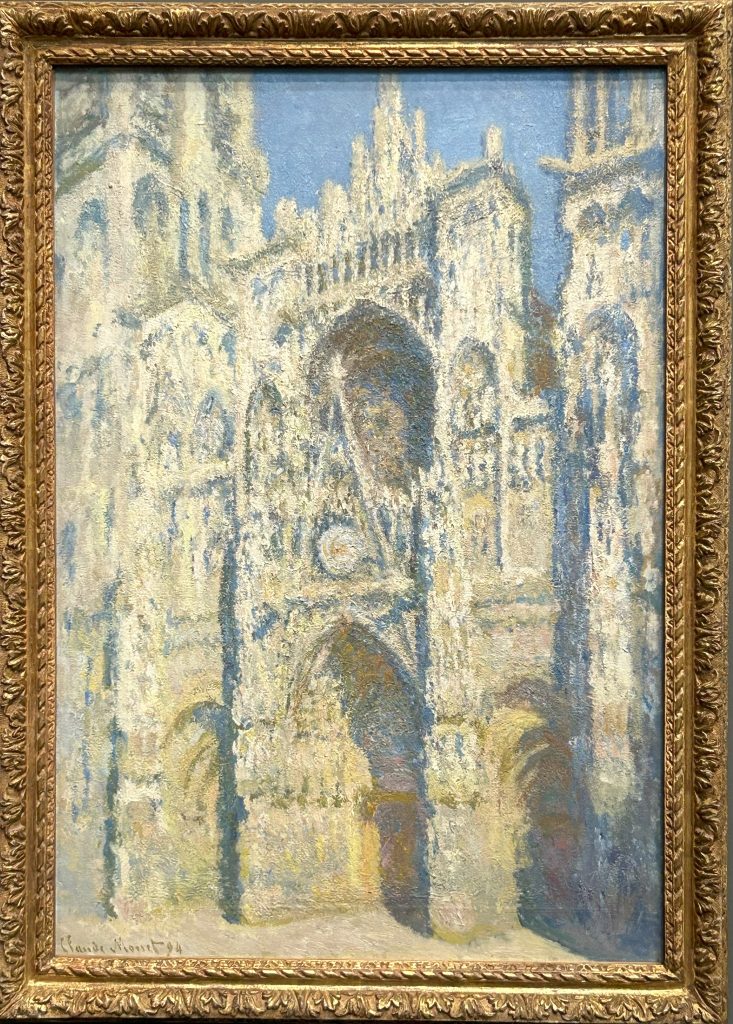Discover the Best of the Musée d’Orsay in Paris
What is the “best of the Musée d’Orsay”? That’s a matter of opinion for sure!
What I think are the best pieces, and what others think is pretty subjective!
But I can confidently say that every artsy traveler who visits the Musée d’Orsay in Paris will not be disappointed.
A visit to the Musée d’Orsay is always a high point for me, no matter how many times I walk through the grand hall on the main floor and ride the escalators to view the outstanding collection of Impressionist and post-Impressionist art on the 5th floor.

The Musée d’Orsay is more than a must-see for the artsy traveler. It’s akin to a pilgrimage! It certainly ranks as one of my all-time-favorite European museums. In this post, I share some of what I consider the top masterpieces.
Musée d’Orsay at a Glance
- Favorite Artist: It’s a tie between Manet and Morisot
- Favorite Not so Famous Piece: The Floor Scrapers by Gustave Caillebotte
- Favorite Place to Stay in Paris: Hotel de l’Université on the Left Bank
- Recommended Guided Tour: Guided Small Group Tour
Location
The map below shows the location of the Musée d’Orsay (#1) in Paris. Also shown is the location of the Louvre for Renaissance, Baroque and 19th-Century art (#2), the Cluny for medieval art (#3), and the Pompidou for modern art (#4).
Tickets
Always reserve a time to visit the Musée d’Orsay to avoid standing in long lines. You can reserve directly from the museum’s website, or purchase tickets through resellers such as Tiquets.com or GetYourGuide.
Once you’ve entered the museum, consider whether to pick up an audio guide.
Two types of audio guides are available. You can hire one at the museum that will include commentary on the contents of both the permanent collection and the main temporary exhibition on during your visit. Alternatively, you can download an audio guide onto your mobile phone that includes commentary only on the main temporary exhibition.
Touring the Top Masterpieces at the Musée d’Orsay
The Musée d’Orsay’s collection is housed in a converted railway station. As such, part of its attraction is the massive atrium that stretches the length of the museum and is filled with light and sculptures.
Long galleries run either side of the atrium and contain mostly academic paintings from the 19th century. Some of these rooms are skippable, unless you’re a fan of the overly florid, heroic style popular during the mid-19th century.
However, make sure you pop into the galleries to the left that include several masterpieces by Gustave Courbet and Jean-François Millet.

Most visitors head for the far end of the atrium and take the escalators to the fifth floor where they find one of the world’s largest collections of impressionist paintings, in addition to an impressive number of paintings by post-impressionists.
A series of rooms includes works by all the late-19th century biggies–Manet, Monet, Renoir, van Gogh, Morisot, and more.
The following highlights of what see is presented according to artist rather than the order in which you’ll encounter them while walking through the museum. All of the works mentioned are in the collection on the fifth floor.
Edouard Manet
The collection includes several iconic pieces by Edouard Manet. I zeroed in on two of them as representative of my favorite aspects of his work. I like the way he flattens the planes and uses a fairly neutral palette.
Even bright colors such as red and blue have gray undertones. Manet’s work always seems much more understated than the work of some of his contemporaries like Monet and especially Renoir.
Sur la Plage by Manet
Manet’s wife and brother sit on the beach—she is reading and he is staring out at the boats sailing along the English Channel. By making the sky take up a very small percentage of the painting, the focus is on the beach itself and the figures.
Manet’s sketchy, fluid brushstrokes makes the scene look like a snapshot in time, as though at any moment the figures will shift position.

Dejeuner sur l’herbe by Manet
If I had to choose the most famous painting in the Musée d’Orsay, I think it would have to be Manet’s Dejeuner sur l’herbe. It’s also one of my favorites.
I’m certainly not alone in loving this piece, which has been reproduced countless times and analyzed within an inch of its life.
Manet painted it in 1863 and included it in the Salon des Refusés along with other artists who were excluded from the Salon (the exhibition of all the accepted painters of the day).
Manet’s large painting shocked critics and the public because it represented such a marked departure from the academic tradition of only depicting mythological figures as nudes.
In this painting, there is a naked woman next to two men wearing modern dress. She looks brazenly out at the viewer as if to dare them to be shocked. The work was deemed to be obscene not only because of its subject matter but because of its loose brushstrokes, contempt for the rules of perspective, and violent contrasts.
Nowadays, we consider it a masterpiece, and it is certainly arresting.

Paul Gauguin
Gauguin’s paintings always make me smile. He combines bright colors in sometimes startling ways and depicts his figures and his landscapes with a flattened perspective that gives them a pleasing immediacy, as though they could easily step out of the canvas.
Gauguin’s work is exhibited alongside several other painters of the Pont-Aven School.
On a recent trip to Europe, I spent a week in Pont-Aven, mostly because Gregg (husband and usual travel companion and also artist) is fascinated by the work that was done there by painters such as Gauguin, Bernard, and Sérusier, and wanted to be inspired by the same landscape that inspired them.
Paysage de Bretagne by Gauguin
This beautiful landscape of a typical scene in Brittany practically glows. The red and orange bushes on the mid-section contrast intensely with the blue sky and bright green foreground.

La Belle Angèle by Gauguin
Gauguin completed this portrait of Marie-Angélique Satre in 1889. He depicts the woman in traditional dress in a composition reminiscent of both Japanese prints and medieval stained-glass windows.
Perhaps as a nod to his Peruvian heritage (his mother was born in Peru), Gauguin includes a Peruvian-inspired piece of pottery next to his model.

Émile Bernard
Bernard was another painter in the Pont-Aven School. Called Les Bretonnes aux ombrelles, this striking depiction of Breton women wearing traditional dress shows how Bernard, as a post-impressionist, ignored perspective, instead filling both the foreground and the background with his figures, bringing them into prominence.
I’m reminded of medieval paintings where the figures take precedence over perspective.

Paul Sérusier
Another member of the Pont-Aven School, Sérusier has become one of my faves from this period. His work almost borders on abstraction and I love how he uses color.
Le champ de blé d’or et de sarrasin by Sérusier
This golden field takes up almost the entire painting, with just a bit at the top for the sky. I feel like I could walk straight into it and be instantly enveloped in a riot of flowers.

Tetrahedra by Sérusier
Painted around 1910, this piece showing floating objects in a formless space is part of a cycle of pictures by Sérusier that pushed the boundaries of Symbolism towards abstraction.
Sérusier believed that geometric forms were sacred and in this painting he depicts his thinking on the origins of life and the universe. The chromatic range of colors progresses towards the light, passing from the coldest to the warmest shades.
The painting is just a delight!

Vincent van Gogh
It’s never difficult to spot a painting by van Gogh in the Musée d’Orsay since there’s always a clutch of people holding cameras aloft in front it.
There are several van Goghs—all fabulous—but I include here just two that I particularly love.
La Salle de danse à Arles by van Gogh
I was surprised to discover a painting by van Gogh that I’d never seen before. At first, I thought it was by Gauguin because the way the figures are depicted and the colors used remind me of his work.
But nope – it’s van Gogh. What an energetic, lively piece this is! Van Gogh really captured the almost frenzied crush of people, the women wearing Arlesian headdresses, their expressions blank.

The Starry Night by van Gogh
Van Gogh painted a few versions of Arles on a starry night. This one is not quite as well known, but it’s still fabulous. Van Gogh worked by candlelight to complete a night view of Arles illuminated by gas lamps and the Great Bear constellation glittering in the sky.

Henri Toulouse-Lautrec
Although Toulouse-Lautrec hailed from a wealthy family in Albi in the southwest of France, he became famous for his gritty depictions of real Parisians, many of whom were down on their luck, lonely, and marginalized. I’m particularly intrigued by two of his pieces depicting prostitutes.
Blonde prostitute, also known as Study for the Medical Inspection by Toulouse-Lautrec
The partially-clothed model is Gabrielle, a prostitute in a Parisian brothel. She’s getting ready to be inspected for venereal disease. Her expression could be interpreted as angry or stoic in the face of what must have been a very demeaning procedure.

Woman Pulling Up Her Stocking by Toulouse-Lautrec
Toulouse-Lautrec was a frequent visitor to the brothels and was able to sketch the prostitutes in all manner of poses. This drawing shows an everyday act—pulling on stockings—under the watchful eye of the brothel’s Madame.

If you’re headed to southwest France, drop into Albi and tour the marvelous Musée Toulouse-Lautrec.
Maximilien Luce
This artist may not be as well known as many of the others in the collection, but this piece is a striking depiction of the violence that stalked Paris on and off throughout the 19th century.
This particular scene shows the aftermath of Bloody Week (May 21 to 28, 1871) when the Paris Commune was brutally suppressed and hundreds of people were shot down in the streets.

Paul Signac
This gorgeous portrait of Signac’s wife uses very sharp contrasts between complementary colors: yellow with purple, and orange-red with green. It’s a very stylized composition that shares an affinity with Art Nouveau posters.

Berthe Morisot
I’ve long been a fan of Impressionist painter Berthe Morisot and am delighted to discover several paintings that I hadn’t seen before on display at the Musée d’Orsay.
Les Deux Soeurs by Morisot
This painting depicts two dreamy-looking young girls just emerging from adolescence. The blossoming hydrangea symbolizes their imminent emergence into womanhood.
Morisot is considered by many (myself included) to be one of the most impressionist of the Impressionists. She uses very loose brushstrokes and almost abstract backgrounds to convey a real sense of immediacy.
Her paintings look so fresh and alive. I like them so much more than works by painters such as Renoir that can look too over-worked and florid.

Le Berceau by Morisot
This portrait of Morisot’s sister gazing at her newborn child is so tender and domestic. And the way Morisot conveys the sheerness of the fabric draped around the baby’s crib is incredible–again proving just how skilled (and under-appreciated) a painter she was.

Paul Cézanne
Cézanne’s works are so redolent of the south of France that I can almost feel the heat coming off the canvases. His palette of warm greens and oranges perfectly captures the landscape around Aix-en-Provence.
Montagne Sainte-Victoire by Cézanne
Here’s one of many versions of Mont Sainte-Victoire near Aix-en-Provence. It’s such a bright, cheerful painting that perfectly captures the heat and space of one of France’s most beautiful landscapes.

Rochers près des grottes au-dessus du Château-Noir by Cézanne
This piece perfectly captures the profusion of rocks and dense foliage in the countryside around Aix-en-Provence, where I’ve spent a fair bit of time over the years. No wonder painters who came after Cézanne credit him with being the father of Cubism.

Gustave Courbet
One of the most controversial paintings in the Musée d’Orsay is L’Origine du Monde by Gustave Courbet, a foremost proponent of realism. This piece was acquired by the museum in 1995, but wasn’t displayed publicly until quite recently.
When you see it, you’ll know why! It’s an amazing painting!
I have a soft spot for this painting because I read an excellent novel called L’Origine by Lilianne Milgrom and interviewed her on the Art In Fiction Podcast (my podcast featuring interviews with authors of arts-inspired novels!).
Lilianne’s novel tells the story of the painting from its commission by the Turkish-Egyptian diplomat Khalil-Bey to its acquisition by the Musée d’Orsay.
Claude Monet
One entire wall is taken up with a series of five paintings showing views of Rouen Cathedral that Monet painted at different times of day. Here are three of them.



Mary Cassatt
Cassatt joined the Impressionist group after moving to Paris from America in the 1870s.
In this painting, she depicts the young girl, using very subtle white tones to stand out against the brightly colored background. While the clothing is almost sketched in, the face and hands are rendered with gorgeous precision.

Edgar Degas
Degas is most famous for his paintings of ballet dancers at the Paris Opera, and the Musée d’Orsay has several examples, including this one showing dancers practicing on stage.
The figures are in various attitudes–some dancing, some stretching, one even scratching her back. Degas uses subtle tones and ethereal brushwork to convey filmy tutus and barely hinted-at expressions.

Auguste Renoir
I’m not a huge fan of most of Renoir’s work. He’s an important painter but I find his figures a little too florid. The exception is, for me, this piece called Danse du Moulin de la Galette, arguably one of the most famous of Renoir’s paintings.
It depicts the famous guinguette–an open-air drinking establishment with food and dancing–that was located at the foot of a former windmill on the Butte de Montmartre in Paris.
The dance is attended by the working class in Paris, such as shop assistants, artists, workers, and just regular folks. The play of light and shadow bring the painting to life, making the viewer feel like they could step in and take a turn around the dance floor.

Gustave Caillebotte
I first saw and was entranced by this painting in the Musée d’Orsay several years ago. Its subject matter is so different from the other paintings in the collection. It’s not a portrait or a landscape, but instead a depiction of three working men (The Floor Scrapers) who are busily scraping a floor in a fine Haussmann-style apartment in Paris.
Critics at the time condemned the painting’s subject matter as vulgar. Few would agree with that assessment nowadays! There is something so compelling about the concentration of the men and the way in which Caillebotte uses such a limited palette to convey so many tones of browns and grays.
And check out how the light spills in from the window!

Love Among the Recipes at the Musée d’Orsay
After touring the Musée d’Orsay, I couldn’t resist taking a shot of Love Among the Recipes, my fourth novel (set in Paris), in front of the great clock.
The museum plays a role in the novel, with one of its most important scenes taking place on the 5th floor in front of a painting by Mary Cassatt!

Practical Information
The Musée d’Orsay can sell out so buy your tickets online at least a day or two before you plan to travel to Paris (possibly more during the busy summer months).
Tickets for Other Art Museums in Paris
Where to Stay in Paris
Here are four options to consider for staying in Paris. All are on the Left Bank, which is my preferred location.
The Hotel de l’Université is a reasonably-priced (for Paris) hotel is on a quiet side street in the sixth arrondisement, a few blocks from the lively area around rue Bonaparte and Boulevard Saint-Germain.
In the fourteenth arrondisement, I recommend the Hôtel A La Villa des Artistes, which is stylish and in a great location close to some of Montparnasse’s most famous restaurants.
IIn the fifth arrondisement, I recommend the Hôtel Le Clos Médicis which has a great location about a block from the Luxembourg Gardens near the Boulevard Saint Michel.
If you’re looking for an apartment, this HUGE apartment on rue de Sevres on the Left Bank (#5 on the map at the beginning of this post) is pricey,but excellent value because of its size and central location. Compared to a typical hotel room in Paris, it’s almost a bargain (not that bargain is an appropriate word for any accommodations in the center of Paris).
Conclusion
If you’re an art lover, then I suggest making the Musée d’Orsay the first major art museum you visit in Paris, even more important then the Louvre.
The Musée d’Orsay’s collection is smaller and much more accessible than the vast collection in the Louvre and the crowds are considerably smaller. A visit there is well worth several hours of your time on even the shortest visit to Paris.
Have you visited the Musée D’Orsay? What are some of your favorites? Share in the comments below.

